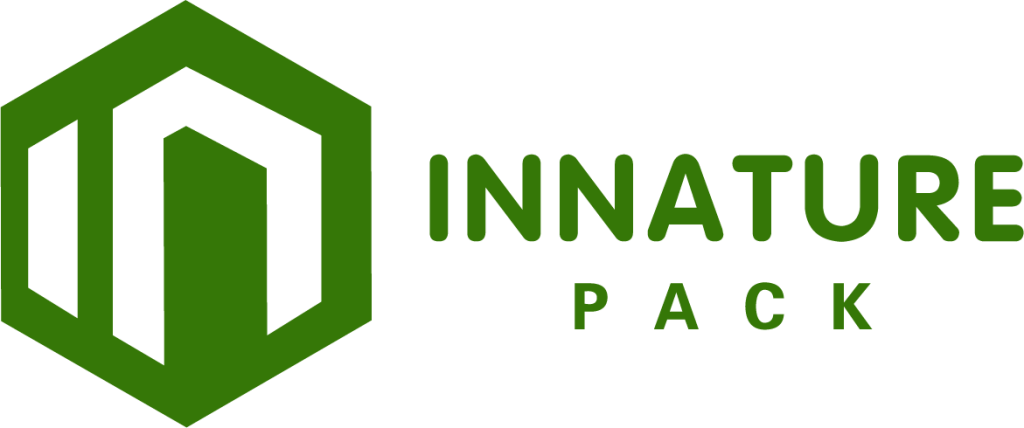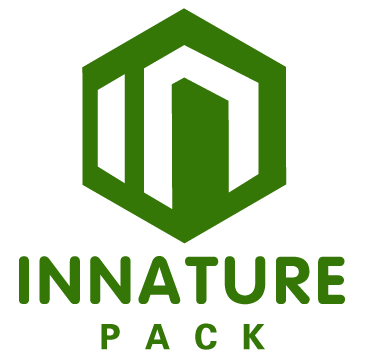Key Takeaways
- So, what do catering packaging products cost? Alternatives including plastics, paper, and compostables have various costs and advantages. Finding the right balance between durability, sustainability, and food safety will be important moving forward.
- Cost Eco-friendly packaging often costs more upfront than conventional materials. It can result in widespread long-term benefits, including a stronger brand reputation and greater customer loyalty.
- While bulk purchasing can provide big savings, it comes with the need for more advanced inventory management practices to ensure items aren’t over-purchased or wasted. Ordering in small quantities can make more sense for companies with less storage space or demand that varies seasonally or week-to-week.
- Customization and decorative design elements, such as branded logos or distinctive shapes, can increase packaging costs. These can sometimes be costly and timely to implement. They frequently deliver a powerful ROI, improving customer experience and strengthening brand perception.
- Innovative sustainable packaging solutions, such as reusable or compostable materials, not only further a brand’s environmental goals but help to fulfill increasing consumer demand. They can result in long-term savings from decreased waste and waste management costs, as well as operational savings.
- Investing in automation technologies or lightweight packaging innovations can help streamline production, reduce labor and shipping expenses, and keep businesses competitive in the evolving catering industry.
Introduce
Catering packaging is instrumental in driving down costs and maximizing customer experiences. Proper packaging ensures food arrives fresh and intact. More importantly, it enhances your brand image and increases customer trust.
With the growing demand for takeout and delivery, many restaurants have reported rising packaging costs. he global takeaway containers market is projected to grow steadily at a compound annual growth rate (CAGR) of 4.1% through 2034. Striking the right balance between quality and affordability is crucial now more than ever. Smart packaging decisions increase operational efficiencies and reduce waste.
They’re an opportunity to enhance the diner experience for customers enjoying restaurant-quality meals at home or on-the-go. Delivery and takeaway orders have increased dramatically. To meet the expectations of customers and remain competitive, businesses need to be aware of catering packaging costs.
What Affects Catering Packaging Costs
Packaging is an often overlooked, yet critical part of successful catering operations, impacting both catering costs and the catering customer experience. By knowing what drives these costs, catering companies can take the right actions to drive down expenses.
1. Material Types and Their Costs
When it comes to catering packaging, the choice of materials plays a crucial role in determining overall costs. Below is a detailed comparison of common packaging materials, including their price ranges, advantages, and disadvantages:
| Material | Price Range | Advantages | Disadvantages |
| Plastic | $0.09 – $0.50/unit | Lightweight, flexible, cost-effective | Environmental impact, potential leaching |
| Glass | $0.20 – $1.00/unit | Chemically inert, recyclable | Heavy, fragile, higher costs |
| Aluminum | $0.10 – $0.50/unit | Lightweight, good barrier against moisture and oxygen | Higher cost, prone to dents |
| Paper | $0.12 – $0.30/unit | Biodegradable, easy to print | Not moisture-resistant |
| Cardboard | $0.05 – $0.20/unit | Strong, recyclable | Limited moisture resistance |
| Bagasse | $0.15 – $0.50/unit | Eco-friendly, grease/moisture resistant, heat resistant | Limited water resistance, shorter shelf life |
Plastics are cheap, but they have no positive impact on the environment; Glass is very durable and great for food preservation, but is more expensive because of its weight and fragility; Aluminum provides an excellent barrier against moisture and oxygen while being lightweight, but it is susceptible to dents which may affect its appearance; Paper, Great balance for businesses that want sustainability without going overboard in cost; Cardboard strikes a good balance of cost and storage strength; Biodegradable catering packaging materials such as bagasse is gaining popularity because it is more environmentally friendly.
Material selection impacts more than just bottom line costs. It affects brand perception, as well as food safety compliance – both important in the catering business. By understanding the advantages and disadvantages of each option, restaurant owners can make informed decisions that align with their operational needs and sustainability goals. Balancing cost with quality will ultimately enhance customer satisfaction while supporting the restaurant’s brand image in an increasingly competitive market.
2. Eco-Friendly vs. Traditional Options
Making the switch to more sustainable packaging may seem more expensive at first glance, but it can have long-term benefits. Traditional plastic catering materials are still very cost-effective, but sustainable options such as compostable trays or bamboo containers will appeal to your green-minded customers.
Compostable packaging investment can increase costs by up to 20%. It doesn’t just improve their convenience—their brand loyalty and positive environmental impact is increased.
Eco-Friendly Material Options:
- bagasse trays
- Bamboo containers
- PLA-lined cartons
- Reusable metal tins
Your catering packaging cost should reflect that consumers today reward the companies that do the right thing. Recent surveys show that about 82% of consumers are willing to pay a premium for sustainable packaging. This growing trend makes sustainable options the best decision for catering services.
3. Bulk Orders vs. Small Quantities
Buying in bulk can save a lot on per-unit costs, but it takes some day-of planning. For instance, purchasing a catering package of 10,000 units of packaging can save you 15-25% over small order quantities.
When overstocking becomes the solution, it creates new issues with storage or waste if materials aren’t used.
Factors to Consider:
- Storage space availability
- Shelf life of materials
- Frequency of catering events
- Initial investment versus long-term savings
Smart inventory management can help find that balance, keeping costs down without being left with an excess inventory.
4. Customization and Design Features
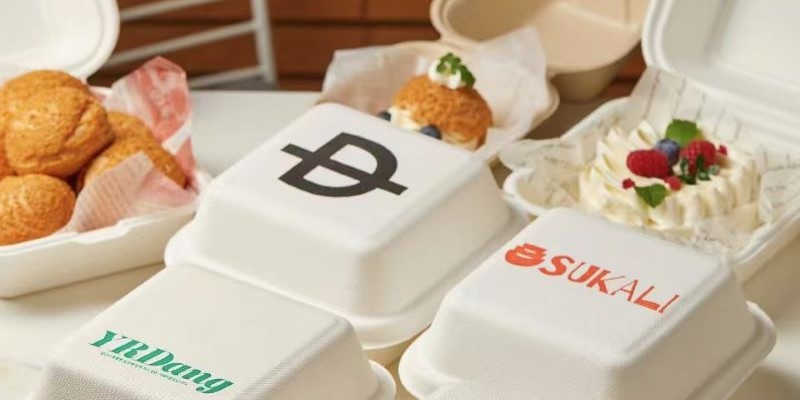
Personalized packaging, like custom printed boxes or packing tape with your logo, further increases packaging expenses, but gives you the opportunity to impress customers. Basic logo printing could cost as little as $0.05 more per unit, whereas full-color printed designs may add $0.20 or more.
Although there is an additional cost, branded packaging provides more exposure and is sure to make a memorable impact on customers.
Popular Customization Options:
- Printed logos
- Embossed designs
- Windowed boxes
- Custom shapes
Spending that cash on design features can make a brand more recognizable, providing a return on investment by bringing in repeat customers.
5. Shipping and Transportation Expenses
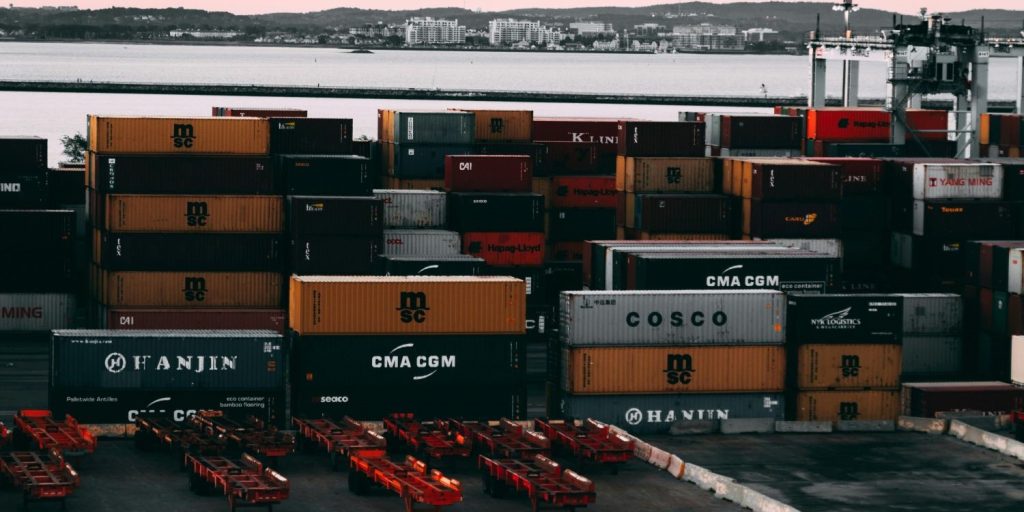
Most shipping costs are determined by the size and weight of the packaging. Lightweight options such as paper-based materials lower transportation costs, while heavy or awkward designs raise costs. Getting competitive quotes from suppliers or sourcing locally can go a long way to reducing these costs.
6. Food Safety and Regulatory Compliance
It goes without saying that ensuring packaging is food safe is a must. Additionally, materials are required to meet FDA regulations, like being free of BPA or resistant to grease.
Failure to comply can result in hefty fines or damage to reputation, so high-quality materials specifically engineered for food safety are crucial.
Hidden Costs in Catering Packaging
Inventory Management
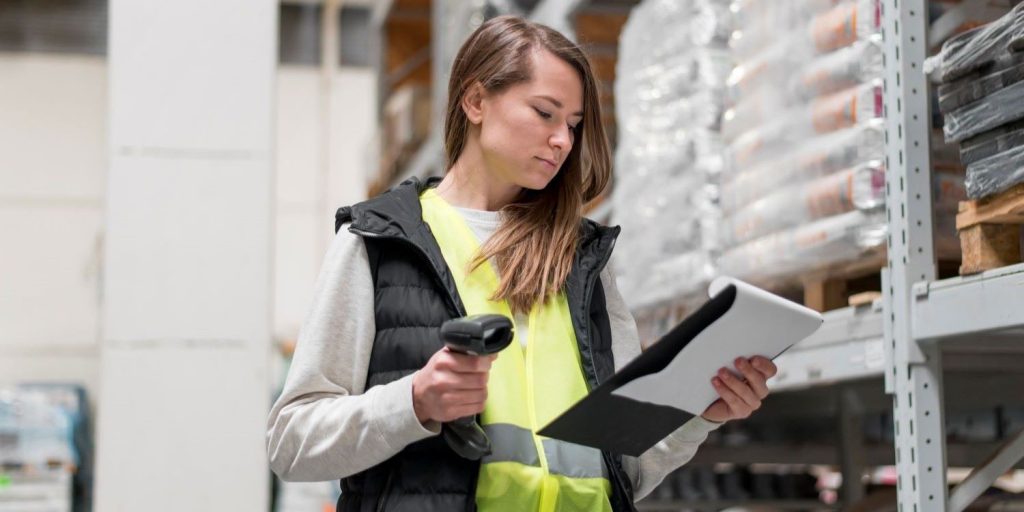
Inventory control for catering supplies is a delicate dance. The true cost of overstocking can leave you with wasted storage space, stock that’s past its prime, and cash that’s tied up and could be spent elsewhere. For instance, a restaurant ordering an excessive number of disposable food containers may find them sitting unused, especially if customer demand changes unexpectedly.
On the flip side, understocking can bring operations to a screeching halt, leading to last-minute, overpriced orders and contributing to packaging availability issues during meal rushes. This challenge is particularly pronounced for businesses with variable customer traffic, such as food trucks or small cafés that rely on takeout catering.
To find that sweet spot of inventory, look to past sales trends and seasonal fluctuations. A tiny café may purchase fewer containers in the slower months but increase their inventory on hand before major events or holidays. Implementing inventory management software can be another useful way to track usage patterns and prevent over-purchasing before it happens.
Businesses should explore partnerships with suppliers to negotiate deals that suit their scale, like bulk discounts for fast-food chains or smaller, flexible orders for independent restaurants.
Waste Disposal Fees
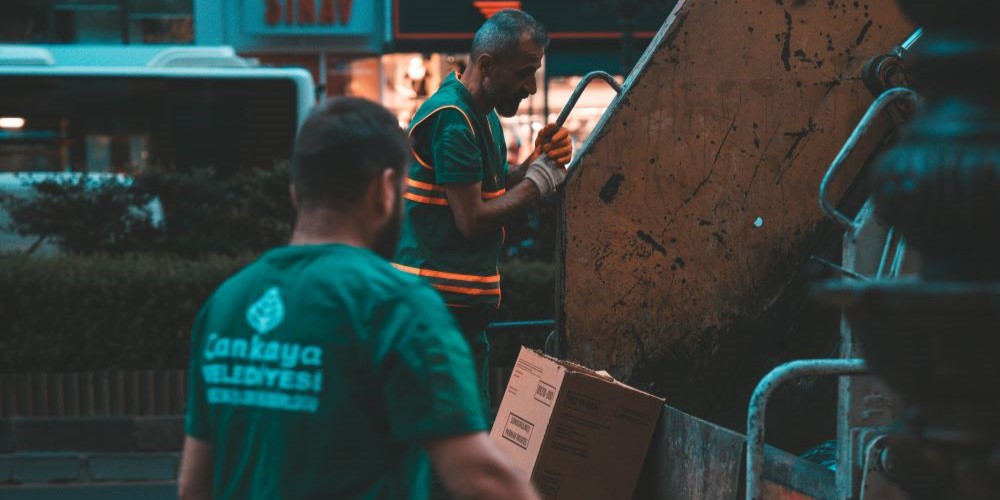
These packaging choices affect much more than the upfront costs. They also affect what a municipality has to pay for waste disposal. Non-recyclable materials, such as single-use plastics, pose severe threats to the environment. As a result, they often increase waste costs due to their lack of disposal options.
These hidden costs can accumulate fast, especially for restaurants that cater to thousands of customers per week. These costs can easily be mitigated over time by switching to more sustainable packaging. Eco-friendly alternatives, like biodegradable containers, are often more expensive initially, anywhere from $0.05 to $0.2 extra per unit.
But the environmental payback of these products is much greater than the upfront cost. For instance, many municipalities today provide lower waste disposal rates for companies that are using recyclable or compostable material. The companies that lead the way on sustainability tend to come out on top, with more than half of consumers saying they prefer brands that are environmentally-friendly.
This strategy not only reduces material waste, but fosters positive relationships with eco-conscious consumers.
Comparing Catering Packaging Types
Disposable Packaging Options and Costs
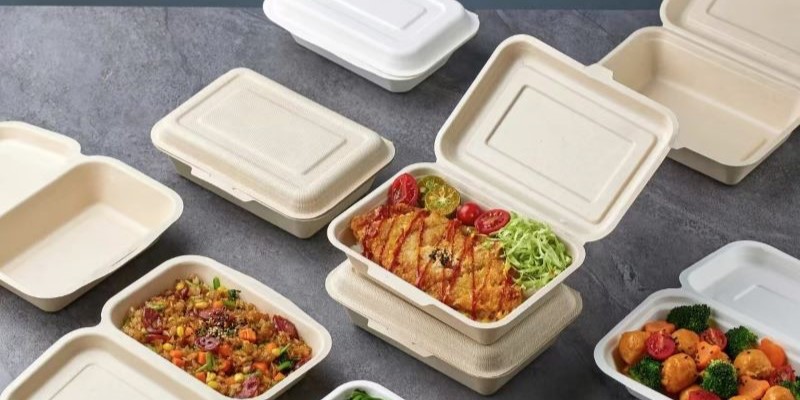
Because of its convenience and accessibility, disposable packaging continues to be the favored option among catering services. These can range from paper boxes to plastic containers, aluminum trays, and biodegradable options like compostable bowls.
These materials are especially attractive to caterers dealing with large events as they cut down on the cleanup time.
Advantages of Disposable Packaging:
- Lightweight and easy to transport
- Single-use, reducing the risk of contamination
- Available in bulk with competitive pricing
Disadvantages of Disposable Packaging:
- Contributes to environmental waste
- Limited durability for heavier or liquid-based foods
From a financial standpoint, disposables are usually more cost-effective at high volumes. Do some quick research here. For instance, basic clear plastic containers can be as low as $0.05 each when purchased in large quantities. Eco-friendly alternatives such as compostable catering boxes tend to cost $0.05 to $0.20 more per unit, which can affect budgets up front.
Reusable Packaging Solutions and Pricing
Reusable packaging provides a more sustainable option for catering companies. Stainless steel trays, glass containers, and more durable plastic bins are popular choices. Although the initial investment is significant, these materials will result in long-term savings.
Advantages of Reusable Packaging:
- Reduces long-term packaging expenses
- Supports sustainability initiatives
- Enhances brand reputation for eco-conscious practices
Disadvantages of Reusable Packaging:
- Requires cleaning and storage space
- Higher initial investment compared to disposables
A stainless steel tray would run about $10-$15 each. You can use it hundreds of times, which greatly reduces your long-term costs.
Reusable systems may face logistical challenges in the return process. Reusables need to be cleaned and sanitized. If you’re on the fence about whether to use disposable or reusable containers, check out our this blog, which may help you make the right choice!
Takeout Packaging Choices for Different Foods
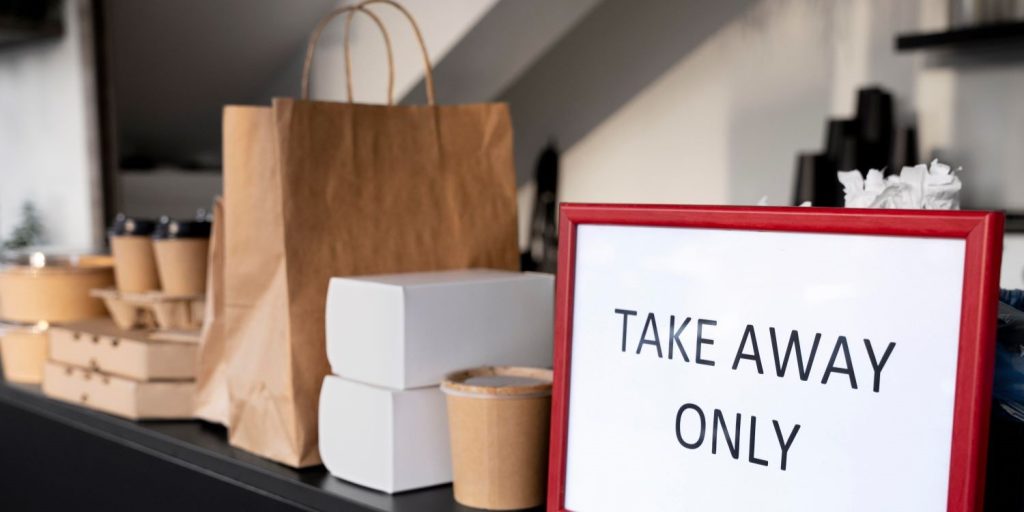
The best takeout packaging overall comes down to one factor — the food. For drier products such as sandwiches, paper wraps or folding cartons work well. Items that have sauces or liquids, like soups and stews, usually need spill-proof containers.
Corrugated boxes work great for heavier meals such as family-sized portions.
Considerations for Takeout Packaging:
- Durability to prevent leaks and spills
- Insulation to keep food warm
- Aesthetic appeal for better customer experience
Additionally, packaging can be an important part of food display. Appealing and high-quality packaging can raise customer expectations and make a great first impression that reflects well on a brand.
At the same time, packaging has to preserve food integrity in transit by providing the right temperature and shielding. For detailed tips on how to choose the best takeaway packaging for your food service, check out this article from us!
Cost of Packaging for Fresh vs. Frozen Items
The differences in packaging requirements and associated costs between fresh and frozen foods are substantial. Fresh items require packaging that allows for breathability to keep them fresh, and frozen items require something durable and moisture-resistant.
Vacuum sealed bags are popular with frozen products, with a cost of about $0.10 – $0.50 each. We know that fresh food packaging is typically made with lower cost substrates such as paper or plastic, but they don’t hold up as well.
|
Category |
Packaging Type |
Cost Range (per unit) |
Key Features |
|---|---|---|---|
|
Fresh Items |
Paper bags, plastic |
$0.05–$0.20 |
Lightweight, breathable |
|
Frozen Items |
Vacuum-sealed bags |
$0.10–$0.50 |
Moisture-resistant, durable |
Temperature control plays a major role in packaging expenses. Frozen foods require heavy insulation materials, which raise costs but allow for a longer shelf life.
Fresh foods take a different approach, choosing more straightforward solutions that strike a better cost-quality balance.
Benefits of Sustainable Packaging Solutions
Reducing Environmental Impact
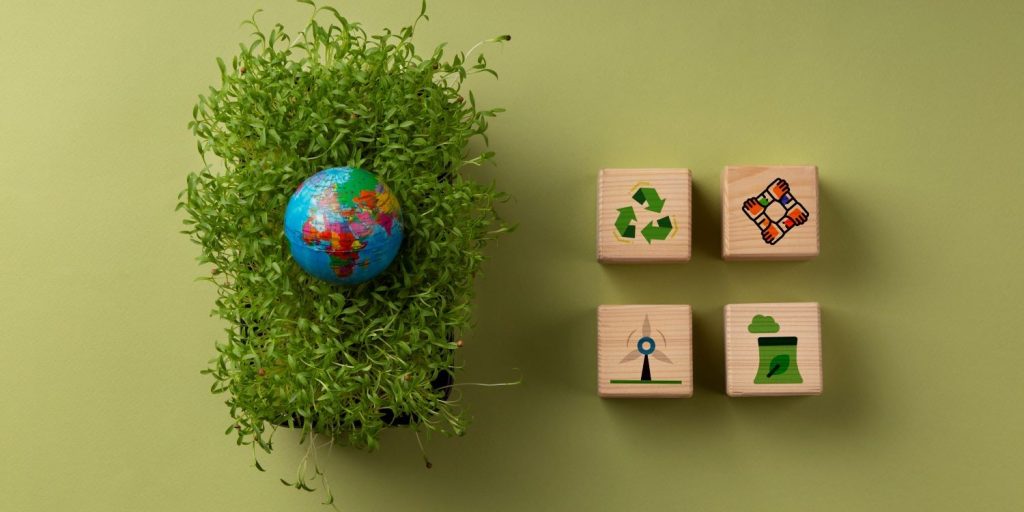
Composting with sustainable packaging materials, such as compostable plant-based packaging reduces waste and brings restorative benefits to the environment. Materials like bagasse, cornstarch, and bamboo are biodegradable and compostable, breaking down naturally and preventing buildup in landfills.
These decisions are reducing carbon emissions and preventing pollution at the source, bringing tangible benefits to our planet. Implement compostable packaging, such as InNature Pack’s compostable, plant-based solutions.
By keeping more waste out of landfills, compostable packaging helps accelerate waste reduction efforts and realize a cleaner, greener future.
Enhancing Brand Reputation
Catering businesses can communicate these efforts by displaying eco-friendly certifications on packaging. Sharing sustainability practices on social media is also effective.
Additionally, educating customers about recycling methods can further enhance brand reputation. Around two-thirds of consumers want sustainable packaging, and sustainable packaging choices like these create a sense of trust and loyalty, leading to more engaged customers.
Long-Term Cost Savings with Sustainability
Sustainable packaging is more cost-effective in the long-run because it eliminates excess material waste and encourages recycling processes. Critical to reducing waste management costs.
Implementing sustainable practices lowers operational expenses, fostering financial stability for catering businesses.
Meeting Consumer Demand for Eco-Friendly Options
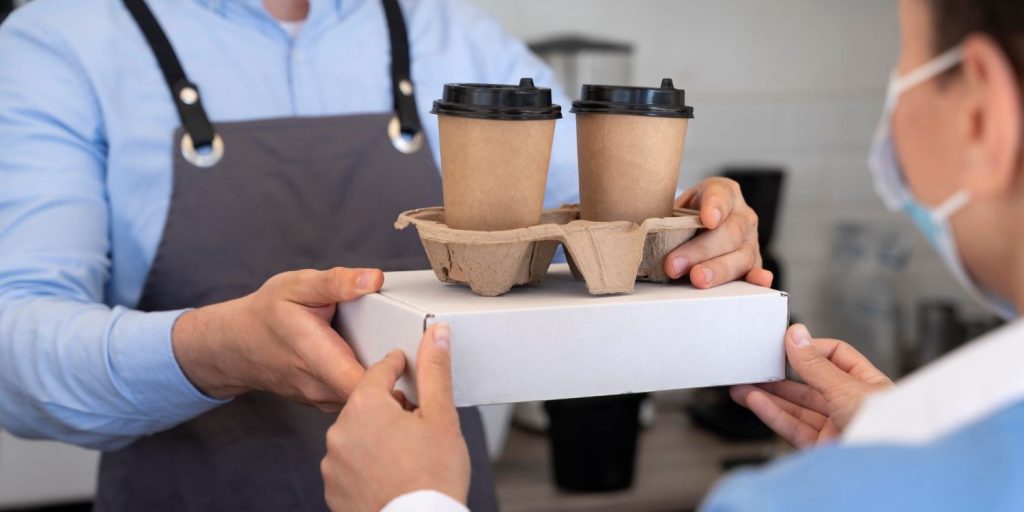
As consumers continue to look for more eco-conscious choices, there’s a growing demand for sustainable catering solutions. Getting ahead of the trend toward eco friendly packaging is an obvious competitive advantage.
This approach meets the demand of consumers increasingly inclined to buy from ethical companies.
Tips to Lower Catering Packaging Costs
Here are five concrete, actionable strategies, along with in-depth analysis to assist you in keeping costs down on disposable food packaging supplies. If you want to learn more practical tips in detail, please refer to this blog post of ours
Buy in Bulk to Save Money
Buying materials in bulk usually has lower per-unit pricing and can save a considerable amount of money. All disposable items such as plates, cups, napkins, food containers, and packaging tape are ideal items to purchase in bulk.
Ordering in bulk reduces the number of orders, which makes inventory management easier and saves time. For example, food trucks that purchase ingredients daily can more easily receive discounts by purchasing larger quantities through regular, established orders.
It’s important to be able to store these items properly to avoid spoilage or goods getting damaged. Warehouse optimization can make an even bigger dent in labor costs while minimizing waste, too.
Opt for Minimalist Designs
A minimalist packaging approach cuts down on production costs without sacrificing a high level of functionality and a clean look. Compared to highly decorative options, simple designs require less material, reducing production costs.
These benefits range from cutting down on waste, improving brand recognition, and creating eye-catching visuals that attract eco-friendly consumers. For instance, catering companies don’t need to have intricate designs printed on catering boxes, when they could have a simple logo on a plain kraft box.
This method keeps menus cost-effective while remaining visually stunning.
Use Sustainable Materials Wisely
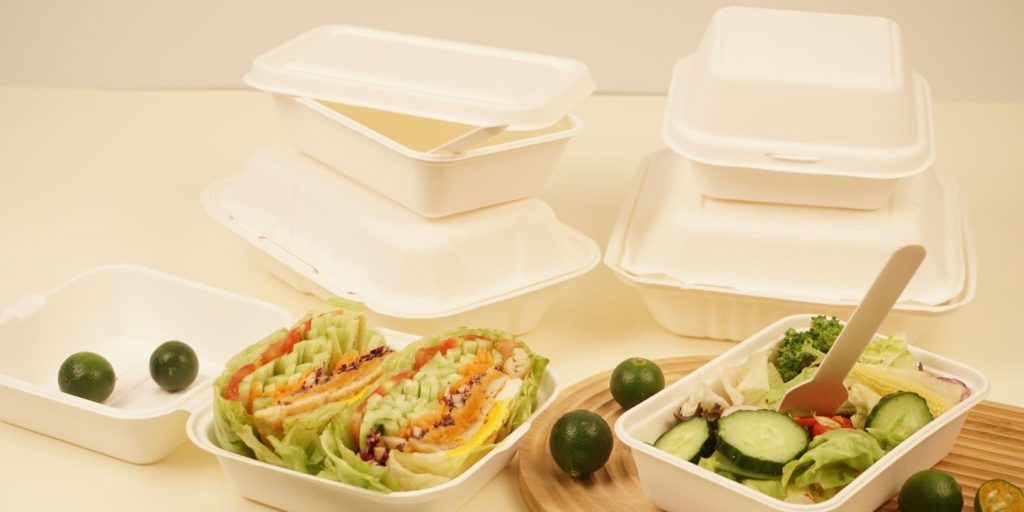
Making a switch to more sustainable options such as biodegradable materials or recycled content often reduces costs over time. Choose renewable resources like bagasse or paperboard for food containers.
To get the most bang for your buck, invest in materials that are budget-friendly—but built to last. As an example, decreasing the use of certain plastics by substituting compostable utensils for plastic forks and spoons can save money and fulfill sustainability goals.
Finding the right balance between sustainability and functionality is key to keeping packaging functional and convenient for consumers.
Partner with Reliable Suppliers
Creating strong relationships with quality, reliable suppliers can ensure a high-quality result for events, as well as savings on products. Find suppliers that are both competitive on pricing, bulk pricing, and flexible in their delivery.
Finding trustworthy suppliers can help with quality control of your packaging and minimize the risk of last-minute delivery issues or shortages. For instance, implementing practices like negotiating long-term contracts can help stabilize prices and make budgeting easier.
Optimize Packaging Sizes and Dimensions
Selecting packaging that fits tight reduces the amount of materials used and increases shipping efficiency. For instance, shipping more items in less boxes lowers transport cost.
Businesses will further help to reduce food waste through portion control, which goes hand in hand with smaller packaging. By eliminating wasted materials, optimized sizes save money and shrink our environmental footprint at the same time.
Future Trends in Catering Packaging Costs
Advancements in Sustainable Materials
This innovation in sustainable packaging materials is picking up steam as companies look for smarter, more sustainable, and more cost-effective solutions. For example, Evoware’s edible packaging made from seaweed is one example of how creativity is combining with sustainability. Likewise, BASF’s antimicrobial foodservice packaging increases shelf life so food is wasted less, saving caterers money in the process.
These innovations further illustrate the promise of sustainable materials to reduce costs even further, all while keeping pace with consumers’ growing demand for more sustainable choices. Benefits of new sustainable materials include:
- Reduced environmental impact through biodegradable options
- Extended shelf life, leading to less food spoilage
- Versatile use in various catering formats
Advancements in materials science are making new options available as well. Mono-material solutions, such as those recently championed by Nestlé, make recycling much easier and cut down on production complexity. The biodegradable packaging market is expected to explode. Innovations such as these will bring down raw material costs in the future.
Role of Automation in Cost Reduction
Automation is transforming the way packaging is produced, providing a straight shot to cost savings. Robotic arms, AI-powered systems, and automated cutting machines are all helping to optimize operations. Key benefits include:
- Faster production cycles
- Reduced labor expenses
- Improved precision to minimize material waste
Long-term financial benefits encompass the reduced cost of operations and reliability of a quality product. As automation technology matures, it becomes more affordable, democratizing access to businesses of all sizes.
Innovations in Lightweight Packaging
Lightweight packaging innovations, such as thinner plastics or compressed cardboard, are rapidly changing the industry. These materials not only save on shipping costs, but they decrease the environmental impact of shipping. The benefits include:
- Decreased fuel usage during distribution
- Easier handling for staff and customers
- Cost savings on raw materials
Choosing lightweight options increases efficiency and makes it easier to reach sustainability goals. So long as these trends continue, they will almost certainly shape the future of catering packaging.
Conclusion
Catering packaging costs vary widely depending on a number of factors, from material choices to hidden costs. Taking a closer look at solutions such as sustainable packaging will create lasting benefits as well as make the Earth a healthier place. Easy fixes, such as purchasing in bulk or simplifying designs, can greatly reduce costs without compromising quality. By staying updated on trends, you’re always one step ahead and prepared for what’s to come.
Finding that balance between budget and quality requires some upfront planning, but the investment pays dividends. Your customers will appreciate your attention to detail when it comes to packaging, plus it helps build a solid brand. An emphasis on detail during the initial stages will pay dividends and prevent painful headaches down the line.
The right choices can have a tremendous impact. It can help you take a deeper dive into what you’re doing now. These small changes will make a huge dent in cost and win you happy clients.
Need help finding the perfect packaging for your business?
Contact us today for tailored recommendations that fit your budget and brand.
Frequently Asked Questions
What factors influence catering packaging costs?
Catering packaging costs vary based on the material used, including disposable food packaging supplies, packaging size, shape, design, and order quantity. As a rule of thumb, sustainable or custom packaging is more expensive, and shipping and storage can further increase costs.
Are there hidden costs in catering packaging?
Yes, hidden costs are things like shipping costs, storage requirements and waste handling and disposal. Not to mention that shoddy packaging can result in food spoilage or damage, driving up costs all around.
What are the most affordable catering packaging materials?
That’s not surprising, since disposable food packaging supplies like paper and plastic are typically the cheapest packaging options. However, they are often not as durable or sustainable as alternatives such as compostable or recyclable materials.
Why should I choose sustainable catering packaging?
Sustainable packaging lowers your business’ environmental impact, improves your brand reputation, and can help you attract more eco-conscious customers. Many states already have laws encouraging sustainable packaging.
How can I lower catering packaging costs?
Always buy in bulk, negotiate with suppliers, and eliminate any excess, pointless packaging. Transitioning to food safe packaging or durable packaging options can yield significant cost savings for your food business in the long run.
What are the future trends in catering packaging costs?
Look to see an increase in sustainable and smart packaging solutions. Growing use of sustainable materials and designs driven by technology may lead to higher average upfront costs, but promise savings in the long run.
Can custom packaging increase my catering profits?
Of course, personalized packaging, such as custom catering boxes, helps build brand identity and develops customer relations. Though it may cost more upfront, it results in increased customer retention and referrals.
